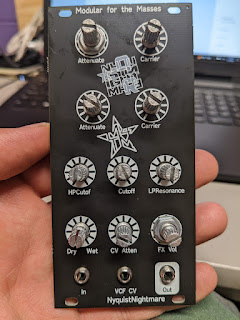Okay, the NyquistNightmare module is probably my most favorite module. It was born out of a desire to get AM radio-like noises out of a module, to introduce aliasing, combing, weird cross-modulations, all these weird noises into a signal. I have a tin-can module that's pretty rough but captures the essence. I have my first PCB version, which the low-pass VCF locks up sometimes for no reason I can understand, a version with an onboard MantisLadder VCF that doesn't lock up but sounds too smooth for my taste (and the SMD capacitors in the ladder were too small electronically but at least large enough to solder four film caps to their edges...
But my new version WORKS! This one uses a MS-20 style filter for the low-pass, using the LM13700 as the variable resistor and the Darlington buffers as the ... buffers. Instead of René Schmitz's approach of using op amps as buffers, which is the MS-20 I build every single time I need a filter.
The NyquistNightmare works like this: there's two voltage-controlled oscillators that can go from some low-ish frequency to way up high, maybe 80KHz, far above what we can hear. An audio signal frequency-modulates the frequency of the first VCO through an attenuator. The resulting modulated signal (oscillating so fast it'll usually be ultrasonic) frequency-modulates the second VCO.
I'm not exactly sure how this works... I can kind of picture it, with two modulated signals cross-cancelling each other out, allowing the original signal to be sort of audible. With very careful adjustment of the four relevant knobs (two knobs attenuating the modulating signals, two knobs controlling the pitch of the carrier signal), you can get a reasonably good version of the original signal out.
The cross-modulated signal can be extremely harsh, extremely rumbly, and very very quiet. So there's extra stuff in the signal chain. First there's a high-pass filter to quiet down the LIGHTNING THUNDER BOOOOM sounds that can come out of the first part. Then there's a low-pass filter to squelch the very piercing and constant squeal-whine.
To address the extreme quiet part, I tossed in two "CinderBlock" circuits, which are auto-gain circuits that act like a really fast mostly not-noticeable compressors that can turn up very quiet signals. Two of those babies.
Finally, there's an LED clipper part that is designed to limit the signal when there's giant voltage spikes. You know, to protect our ears.
There's a wet/dry knob so you can hear what signal you're even putting into the module, and a effect volume knob... which on my prototype I switched, confusing me until I traced my error down on the PCB ha ha.
I'm excited to have a version of this module that I'm happy with! It's one I'm going to have available to build at Knobcon 11 (early September of 2023). It's a rewarding module to play with, even when your input signal is a boring 220Hz sine wave. Something about the signal processing reminds me of what a rubber band does in one of those balsa stick airplane toys, where the rubber band will knot up. On the oscilloscope, the 220Hz sine will suddenly flip on itself, then sections will flip again, until the "knots" get closer and the smooth sine parts get shorter... and the sound is pretty neat. I made a TikTok demo real quick haha kids these days




Oops, I spoke too soon. I am gonna add two more CV inputs to allow a LFO (or whatever) to make the cross-modulation signals wander, if so desired. Which means the whole PCB needs redrawing whee
ReplyDelete